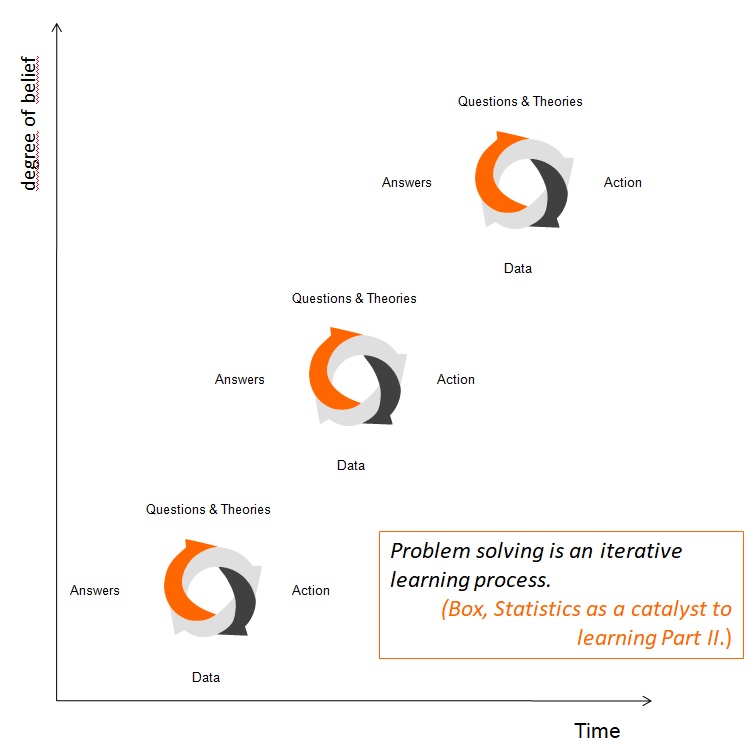What is needed for improvement – DMAIC or PDSA?
Today’s pace of life and business is incredibly fast. We strive to keep up – both in our daily activities and in our long-term strategic plans. We want to act quickly, efficiently, and effectively. We expect ready-made solutions, best practices, and proven workflows. At first, it often seems like it’s working – the results are indeed rapid, and many people are delighted. However, in the long run, this has nothing to do with lasting improvement.
True effectiveness and sustainability of change begin with understanding the basics and asking three fundamental questions:
- What do we want to achieve?
- What methods do we use to achieve it?
- How do we know we’ve achieved it?
These are simple, yet challenging questions – relevant to CEOs, managers, and Six Sigma practitioners (Green Belts and Black Belts).
The answers to these questions allow us to direct our actions – above all, to distinguish between routine and discovery projects. Both types are important, but require different methods and tools. In the context of Six Sigma, this distinction is crucial.
We often hear the question:
Can Six Sigma projects be implemented anywhere?
The answer is no.
Routine projects—those in which the solution is known and success depends primarily on time and resource management—do not fall under the Six Sigma umbrella. The second type—discovery projects—require a combination of expert knowledge, theory, and tools that allow for effective hypothesis testing and building an understanding of cause-effect relationships. The knowledge discovery process is iterative and multi-level, and theories are usually numerous.
Kliknij, aby powiększyć
PDSA – the natural choice for discovery projects
Deming’s PDSA (Plan–Do–Study–Act) model is a natural choice for discovery projects, particularly in activities requiring iterative knowledge building about cause-and-effect relationships.
- In the Study phase, Green Belts utilize tools such as Components of Variation (COV) and Design of Experiments (DOE) to determine the sources of variation and the impact of factors on the metric of interest.
- In the Act phase, conclusions are drawn, theories are verified, and new questions are formulated for the next cycle.
The Deming model is ideal for Six Sigma projects, providing flexibility and applicability in various areas – from R&D, through industrial engineering and technology, to quality projects. It perfectly addresses the need for iterative action, essential in discovery projects. It is a universal model and widely recognized in organizations – from everyday operations on the shop floor to complex technological projects.
PDSA is not a ready-made roadmap to success – it requires combining expert knowledge with appropriate concepts and tools.
Kliknij, aby powiększyć
DMAIC – structured but less flexible
The second Six Sigma model widely used in organizations is DMAIC (Define–Measure–Analyze–Improve–Control). This model, based on the Deming cycle, introduces greater detail and clearly defines the boundaries between project stages, guiding us through the project in a linear fashion. This makes it well-suited for activities requiring structure and control – but this advantage can also be a disadvantage.
In discovery projects, it’s difficult to plan all stages in advance. It’s not always clear whether a single DOE experiment or several series will be needed to confirm the root cause – which is crucial for moving from the Analyze to Improve phase. Therefore, a linear management system with defined “gates” works well for routine projects, but in discovery projects, it requires greater flexibility and an understanding of the specifics of the process. This, of course, doesn’t mean that timeframes can be avoided. Frameworks are necessary – however, the reporting and planning methods should reflect the nature of the project.
It’s also worth remembering that DMAIC has limited application flexibility. It works well for reactive projects—e.g., reducing defects, eliminating rework, or eliminating market defects—but it’s not ideal for R&D, technology, or engineering. The DMADV (Define–Measure–Analyze–Design–Verify) model is more appropriate for these areas, as it better captures the nature of activities in each phase.
In summary: DMAIC isn’t a bad model, but it requires appropriate conditions and awareness on the part of Green Belts and Black Belts.
Which model should I choose?
The answer depends on the project’s goal, its nature, and the organizational culture.
The program we implement with our Green Belts and Black Belts prepares them for work in every department – from R&D and engineering to quality departments. We teach future Six Sigma practitioners how to properly define projects to ensure they are explorative in nature. We also build connections with Lean Manufacturing, which is based on the PDSA model – hence our preference for working within this cycle.
However, the DMAIC and DMADV models can also be used effectively – provided the Green Belt and Black Belt understand when and why to use them. During our workshops, we demonstrate how to integrate these tools into the subsequent phases of the DMAIC cycle and how to conduct a project using this model as well. A knowledgeable, well-prepared practitioner who can:
- identify the project type,
- define appropriate metrics,
- conduct measurements and analysis of variation (COV),
- effectively use DOE experiments,
- and control the process using control charts –
will be able to manage projects using both the PDSA and DMAIC/DMADV models.



